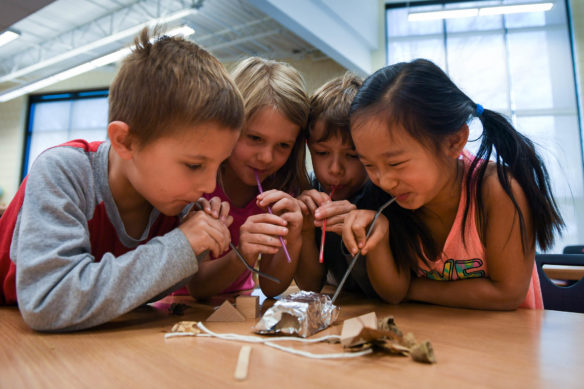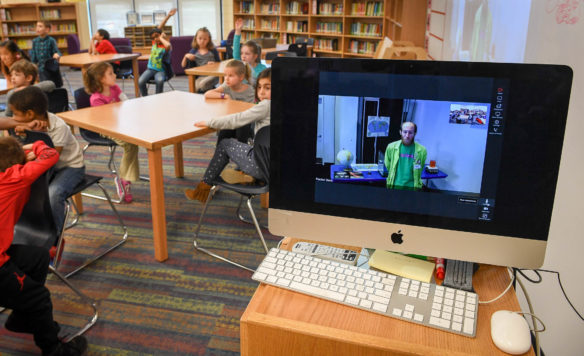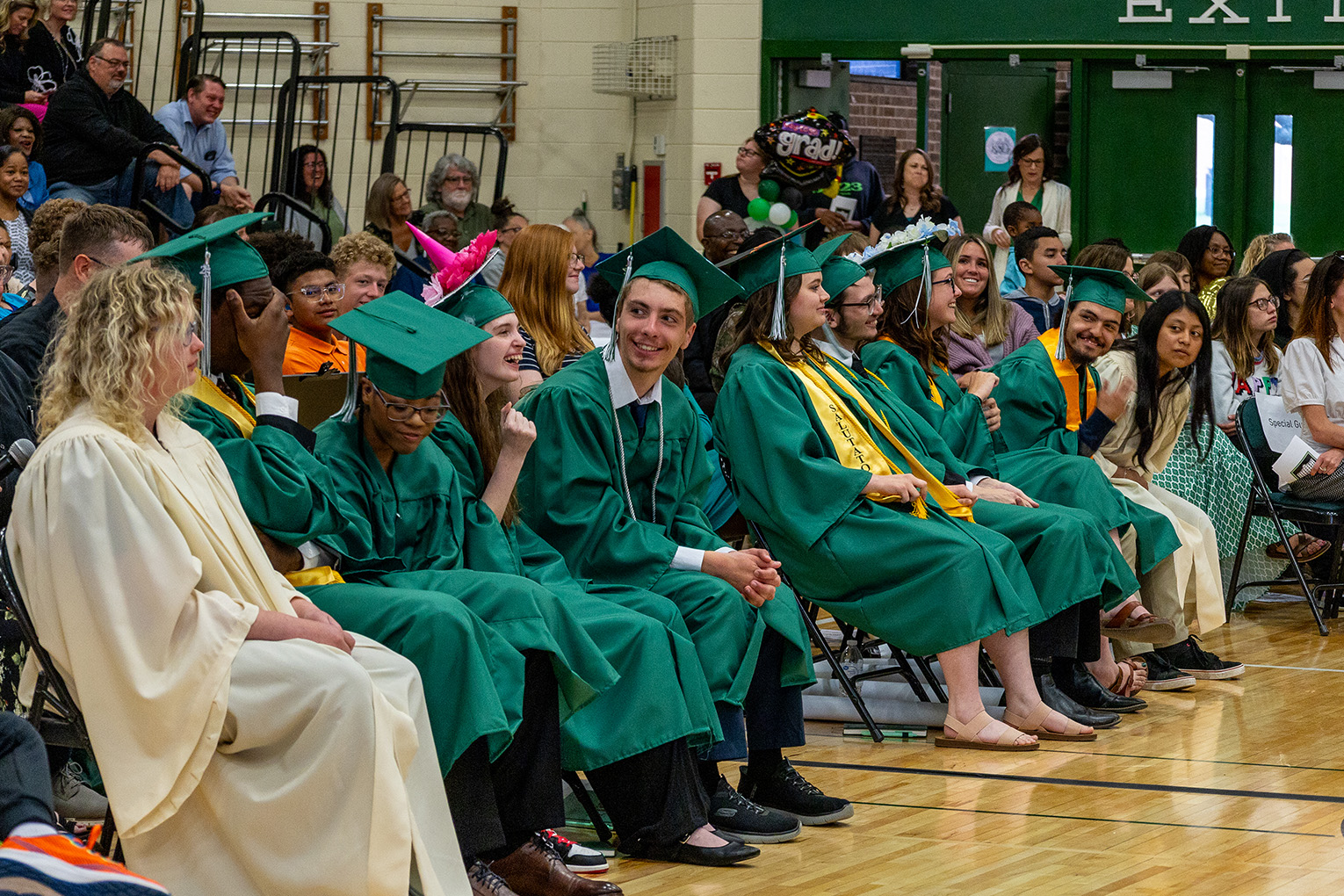
First-grade students at Lowe Elementary School (Jefferson County) use straws and different construction materials to experiment with wind while taking part in a distance learning session with the Kentucky Science Center. The center offers distance learning programs for students at all grade levels.
Photo by Bobby Ellis, March 14, 2017
By Mike Marsee
michael.marsee@education.ky.gov
It started, as so many achievements in science have, with a question.
First-grade student Noah Anderson wanted to know about the strongest kind of storm there is, and that’s what led the Kentucky Science Center to bring its distance learning program to Lowe Elementary School (Jefferson County).
The center’s Beam Us In program is ideally suited for such questions – and for helping students discover the answers to them through their own investigation.
“Teachers are always amazed to see the behavior that comes out of their kids when they are in charge of their learning process,” said Rachel Beck, the science center’s education coordinator. “We don’t really dictate where they go after that. We have a wide path and we develop some stops along the way to encourage that process. Whatever they make of that information is up to them.”
The science center’s distance learning program has been in place for some time, but Beck said much of its work has been with students in other states and even outside the country. Christine Duke, an elementary science consultant with the Kentucky Department of Education, said the program is an asset that should be utilized by more Kentucky schools.
“It’s a tremendous resource for our teachers and library media specialists,” Duke said. “This program supports students as they engage in sense-making using the tools grounded in science and engineering practices as well as the crosscutting concepts. Students aren’t just given the answers to their questions; they’re encouraged to use their tools in order to support their own conclusions. This program fosters student thinking of the ‘why’ of a phenomena rather than the ‘what’ that emphasizes recall of facts.”
At Lowe Elementary, that process started when Becky Hinkle’s 1st-grade students were asked to come up with “I wonder” questions – individual questions that students might ask as part of their learning – as part of a class project. They researched and investigated the answers to many of their questions with the help of library media specialist Linda Wrins-Ryan, but not all of them.
“Some of the questions were just a little too difficult for them to find the answer,” Wrins-Ryan said. “And even watching it on a video, they were struggling with it.”
Wrins-Ryan contacted Beck at the science center in January, and the center prepared three lessons to find the answers they were looking for to these questions:
- Why does the Earth spin? And what is it like to be in space or in a space ship?
- How did triceratops live?
- What is the strongest storm and what happens during it?
“We worked together and figured out a way where maybe students could understand their wonder questions through investigation,” Wrins-Ryan said. “About 85 percent of these students are kinesthetic learners, so they need that hands-on experience.”
She collaborated with Hinkle and contacted the science center to see how they could help the students understand the answers to their questions rather than merely learning facts.
In the session on storms last month, students assembled in the library to hear science center staff member Brian Morris, who joined them via video conference, and meteorologist Matt Milosevich of WLKY-TV, who joined them in person and presented a video. The two talked about the wind storm that struck Louisville in 2008 as part of the aftermath of Hurricane Ike.
Hinkle said her favorite part about the program is that got her students excited about science.
“It just sparks their curiosity and it validates their questions,” she said. “They think, ‘My questions are important if other adults are going to help me find ways to answer them.’ So it’s just powerful for kids for science learning.”
Hinkle’s students followed up on their sessions with writing exercises, and she said they also wrote things for their parents about what they learned.
“That question, ‘What did you do in school today?’ The kids have something really important that’s on their mind and they want to share it,” she said.

Brian Morris, a member of the education staff at the Kentucky Science Center, speaks to 1st-grade students at Lowe Elementary School from the center using a video conferencing system. The center’s distance learning programs include two or three interactions with a class using a video conferencing platform that allows it to connect with any existing technology in schools.
Photo by Bobby Ellis, March 14, 2017
A typical distance-learning program from the science center includes two or three interactions with the class over a period of one week or three weeks. The center uses a video conferencing platform that allows it to connect with any existing technology in Kentucky schools.
To begin the process, teachers are sent a packet with materials and instructions for a brainstorming session with their students. Science center education staff members will spend only a short time with the class on this day because they want the teacher and students to carry the brainstorming process into the second connection between the center and the classroom, which they often do without center staffers.
In that second connection, students can start conducting their own investigations based on their ideas and teachers ask leading questions to keep them moving forward. The center’s role is to model to the teacher the types of leading questions to ask. Teachers also may show photos and videos provided by the center that relate to their questions.
In the third session, students have come to conclusions and are ready to present to a center staff member through a videoconference. Students don’t all have to reach the same conclusion, but they are asked to explain their reasoning and why they think they have the best solution.
“This is something that we want to provide as a support system, and it can be tailored to teachers’ needs and their students’ needs,” Beck said. “It may not be well-suited for STEM classes that are rolling along, but this is really for those unique projects like Linda is doing and anyone else who is looking to enhance what they’re doing in the classroom.”
Beck said the program also is ideal for educators such as Wrins-Ryan.
“Media specialists like her really are the gateway to a lot of this open-ended learning,” Beck said.
“Our belief and our mission as library media specialists is to create lifelong learners,” Wrins-Ryan said. “We want them to come and investigate and just to wonder and to think and to grow. As they get older, hopefully they’ll remember and they’ll always know, ‘I can always go to the library, because the answers are there.’”
Wrins-Ryan said she also wants other schools to take advantage of what the science center has to offer.
“I think this is an amazing program that they have, and I think the students can benefit from it. I just hope other schools learn about it,” she said.
MORE INFO …
Rachel Beck rachel.beck@louisvilleky.gov
Becky Hinkle becky.hinkle@jefferson.kyschools.us
Linda Wrins-Ryan linda.wrins-ryan@jefferson.kyschools.us







Leave A Comment